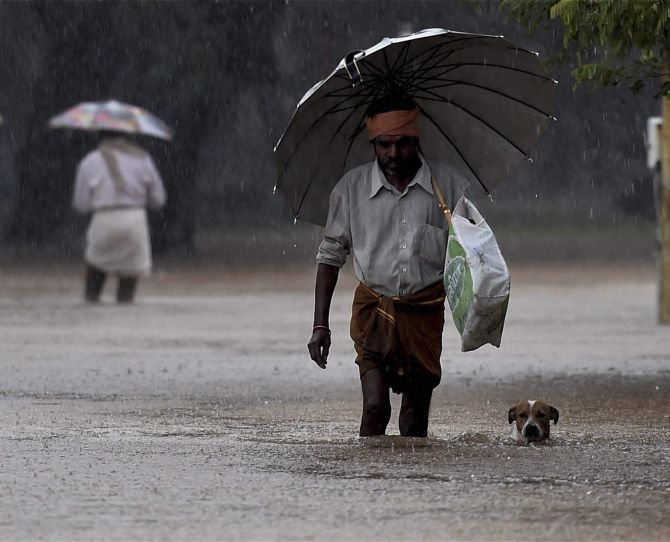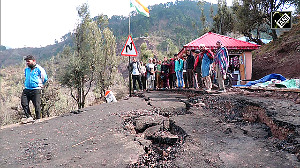While the IMD had forecast a ‘normal’ monsoon for the entire season, Skymet stated that rain this year would be ‘below normal’, report Sanjeeb Mukherjee and Sahil Makkar.

The State-run India Meteorological Department and the country’s largest private weather forecaster, Skymet, have once again found themselves in the eye of the storm over the accuracy of monsoon predictions.
The monsoon, after making a steady start in June and July, went for an extended break in August and early September, pulling down the total cumulative seasonal rainfall.
The 2017 southwest monsoon season ended on September 30, with an overall shortfall of 5 per cent from normal. In meteorological terms, it could be classified as ‘below-normal’ at 95 per cent of the Long Period Average.
However, the IMD had forecast a ‘normal’ monsoon for the entire season at 98 per cent of the LPA, with a model error of plus and minus 4 per cent.
Specifically for August and September, the IMD predicted the rain to be normal at 99 per cent of LPA, with a model error of plus and minus 9 per cent.
While rain in August was 13 per cent less than normal, in September it was almost 12 per cent lower than normal.
According to the IMD, the unexpected break was caused by intra-seasonal variability as Pacific cyclones over the Bay of Bengal pulled the monsoon currents towards them, leading to disappearance of rain over central and northern India, plunging the regions on the brink of drought.
“Such transitional systems are difficult to capture in seasonal prediction models, but the breaks hadn’t caused big damage as seen by week-on-week sowing data progress and also water level in reservoirs this year, compared to the previous years,” said K J Ramesh, director general of the IMD.
Skymet has disputed IMD’s claims on the breaks and also on the accuracy of its forecast.
“This (extended break in monsoon) typically happens in an evolving El Niño year and we have always been saying that in our predictions,” Jatin Singh, chief executive officer of Skymet, said.
Skymet pointed out that in March itself it had stated that rain this year would be ‘below normal’ at 95 per cent of LPA and that it stuck to its prediction throughout the June to September season.
In contrast, IMD kept updating its forecasts, giving the notion of a ‘normal’ monsoon this year, the private weather forecaster said.
“Skymet Weather had announced its forecast on March 28 and stuck to the same till the end of the monsoon season. Meanwhile, other organisations kept updating their forecast from time to time. In fact, the country’s nodal weather agency, the IMD, had also updated its Monsoon 2017 forecast from 96 to 98 per cent,” Skymet said in a note published on its website.
While the two agencies try to figure out the real reasons for the forecasts going off the mark, the data showed that almost 34 per cent of the 660 districts in the country received deficient rain this year till September 27, while 66 per cent got normal rain. In 2016, during the same period, the proportion was 67 per cent normal and 33 per cent deficient.
Even as these numbers may not look alarming statistically, at a segregated level there is a cause for worry at least in Punjab, Haryana, Uttar Pradesh, Vidarbha and Delhi where rainfall this year has been around 20 per cent below normal.
Also, around 33 districts in Madhya Pradesh, 42 in Uttar Pradesh, some areas in Odisha, Telangana, Chhattisgarh and Rajasthan have been put under the ‘watch list’ for drought or drought-like conditions developing over the next few weeks.
For the kharif season, states can declare drought in any part till October 30, while for the rabi season it has to be declared not later than March 31.
“Overall, as of now, no state has officially declared drought in any district or any part. But many states have kept it under watch list,” Ramesh of IMD said.
The states themselves are finding it difficult to declare drought because of the revised drought manual introduced last year. Despite receiving scanty rainfall, the changed manual has made it difficult for states like Kerala and Karnataka to declare drought. The new manual, based on international practices, was drafted and put in place following Supreme Court’s directions.
The new guidelines mandate a state to fulfill all parameters, such as rainfall, vegetation, hydrological indices, crops situation indices, ground verification and others, before declaring the districts under the impact of severe drought.
States get financial assistance from the national disaster relief fund when a district is declared hit by severe drought.
In case of mild drought, states have to provide own funds to mitigate the situation. In the previous manuals, many of the parameters were less stringent.
“The new guidelines have created a problem for wettest states such as Kerala and those in the Northeast. We had objected at the secretary-level meeting called to discuss the guidelines. We were only given 15 days to send our inputs on a 300-page draft report,” said a senior official in the Kerala government.
The official said in states like Kerala and the Northeast the drought was more about drinking water.
“Crops can be cultivated through the water in reservoir. But our territory is such that rainwater can’t be harvested. The groundwater is already depleted and we have banned the use of hand pumps in the state,” the official said.
Karnataka, which too has seen scanty rainfall in many districts this year, has expressed concern to the Union government, including through a representation made to Prime Minister Narendra Modi.
But many Bharatiya Janata Party-ruled states such as Madhya Pradesh want to proceed according to the new manual despite many districts having received 30% less rains.
“The new manual is more scientific. The Centre is asking for remote sensing and groundwater details and I don’t think it should be a concern. We follow the new norms,” said Arun Pandey, principal secretary (revenue), in the state government.
As to whether India faces another year of drought in some parts, that could further cripple the already slowing economy and aggravate the agrarian distress, will only be known in the next few months.
Photograph: PTI Photo.












 © 2025
© 2025